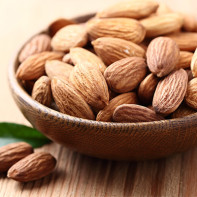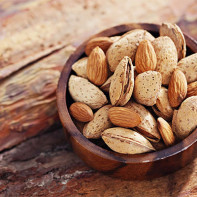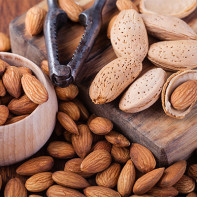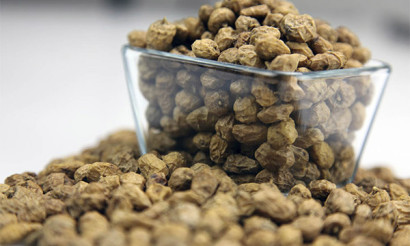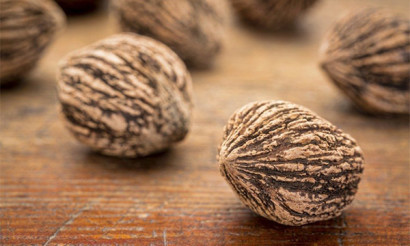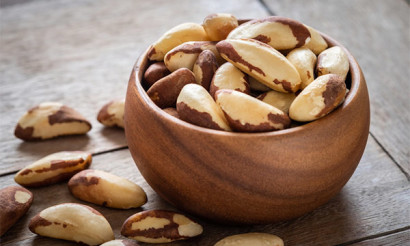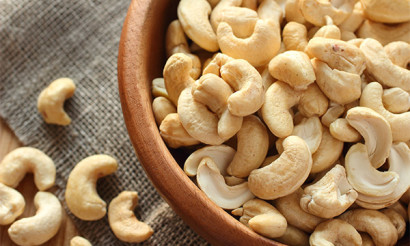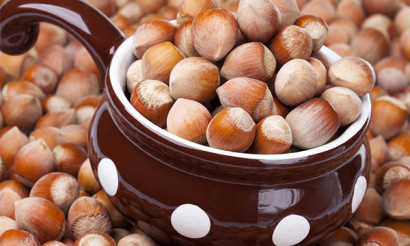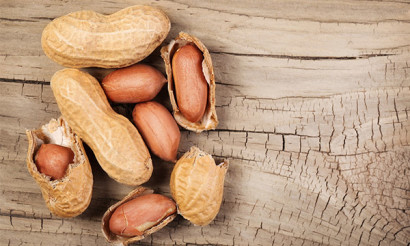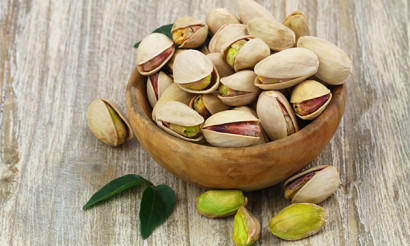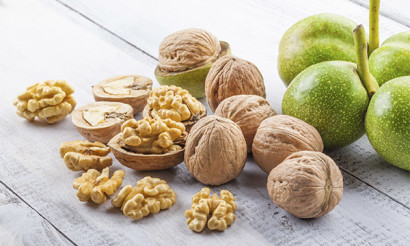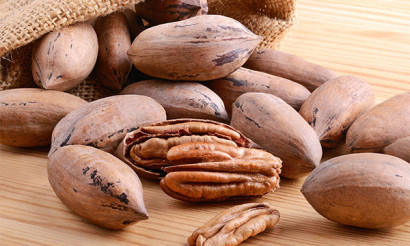Almonds: benefits and harms for the human body
Almond kernels are one of the most beloved delicacies all over the planet. A delicate and refined shade of the taste of nutritious nucleoli brings not only pleasure, but also great benefits to the body, helping to build a proper and balanced diet, calmly transfer the diet and overcome stress. Let's take a closer look at this delicacy and find out whether it is worth introducing almonds into your diet, how to do it right.
- How almonds grow
- Kinds
- What is the difference between almonds and apricot kernel
- Which is healthier: almonds or cashews
- Composition and calorie content
- What is almonds good for?
- General benefit
- For women
- For men
- During pregnancy
- When breastfeeding
- For kids
- Which almonds are healthier: raw or toasted
- How to fry
- Almond oil: benefits and applications
- The benefits of bitter almonds
- Useful properties of almond milk
- How to do
- Urbech from almonds: benefits and harms
- Is it possible to eat almonds while losing weight
- Almonds in medicine
- With diabetes
- With pancreatitis
- With gastritis
- For the intestines
- For constipation
- With gout
- For the liver
- With hemorrhoids
- With cholecystitis
- Almonds in cosmetology
- The use of almonds in cooking
- Harm and contraindications
- Almond Allergy Symptoms
- How to choose and store almonds
- How to eat almonds
- How much can you eat per day
- Can I eat at night and on an empty stomach
- Is it possible to eat raw almonds
- Is it possible to eat with a peel
- Do I need to wash before use
- How to quickly peel almonds
- How to make almond flour at home
- Is it possible to give animals almonds
- Interesting Almond Facts
How almonds grow
Almonds are considered one of the most recognizable and popular nut kernels in the world. In its nutritional qualities, it is similar to hazelnuts, cashews, Brazil nuts or chestnuts - fatty, rich in oil and valuable vegetable protein fruits with a characteristic taste fit right into the nut line. However, from a botanical point of view, almonds are a drupe with a nutritious seed inside and unfit pulp outside.
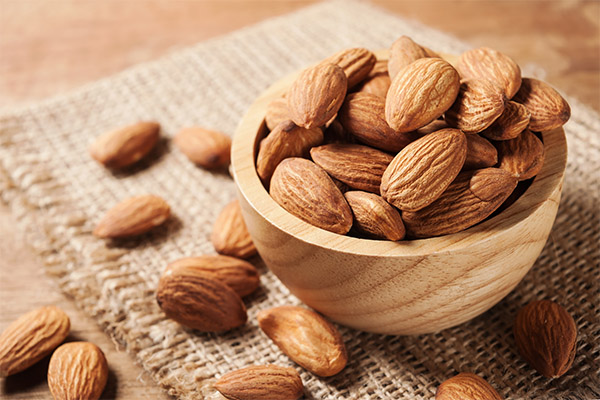
Almond tree grows in temperate climates on the plains and in rocky terrain. Its natural habitat is Central Asia and the Mediterranean. The plant can reach several meters in height and bear fruit abundantly. Young almond tree can also be grown on its own site - in the first years it will be fragile, like sea buckthorn or sumac, and then it can grow like mountain ash or mulberry.
The plant belongs to the Rosaceae family and is distinguished by sophisticated beautiful buds of soft pink color. Almonds are harvested in late summer – early fall, on an intentional scale they use special equipment - a machine like a cargo crane that grabs a tree trunk and creates a vibration. At this time, all ripe fruits fall from the branches, which are then harvested, cleaned and processed for sale.
Kinds
Strictly speaking, almonds are a noble nut-type plant. Its fruits, or rather grains of seeds, are distinguished by a delicate texture and a pleasant sweetish nutty flavor. Such almonds are considered food and safe for health.
But you can also find a similar product called bitter almonds. By this name is meant apricot, peach or nectarine seeds. Since such an “almond” is much cheaper, sometimes unscrupulous sellers give out bitter almonds as noble, selling it with a large margin.
You need to understand that bitter almonds are not safe for the body, because it contains toxic substances. As a rule, apricot kernel is used in folk medicine, but sweet almonds cannot be replaced with this product in cooking recipes.
What is the difference between almonds and apricot kernel
Food almonds are called sweet for a reason - it has a very pleasant taste and is characterized by high nutritional value, contains high-quality vegetable proteins and oils.Peeled apricot or peach kernels, very similar in shape to a fragrant nut, do not possess such properties, the nutritional composition of their grains is different, and most importantly - not so harmless. The main feature of sweet almonds is that it can be safely used without harm to health, while bitter is dangerous not only for people, but also for animals.
Apricot kernel is sometimes used for medicinal purposes for external use. Alcohol infusions and compresses with gruel of these grains help with joint pain and contribute to the cure of varicose veins. However, apricot almonds are not consumed.
Bitter almonds have a characteristic unpleasant sharp taste characteristic of amygdalin compounds. This substance is poison and in no case should it be ingested by children or small pets. The critical dose for an adult is 50 pieces of nuts - after this, a fatal outcome may occur, but 8 grains are dangerous for children.
A small organism is not able to break down and digest the named substance, which means that it can accumulate in the liver and poison the blood. Therefore, the use of bitter almonds should be abandoned.
Which is healthier: almonds or cashews
Comparison of nuts among themselves always causes controversy, since each of them has its own advantages. For example, cashews are considered one of the fattest nuts along with walnuts and pecans. It is these nuts that contain less complex proteins and fiber that are much better absorbed by the body in its raw form and do not cause digestive discomfort.
Almonds, in turn, are a dietary nut. Its energy value among brothers is quite small. That is why it is recommended more often than other nutritional nuclei to maintain the body on diets for weight loss, recovery of the body after long illnesses and long-term treatment.
Almonds are not the richest nut in their composition; therefore, nutritionists and health food gurus recommend alternating delicious fruits in the diet in order to saturate the body with a diverse set of usefulnesses.
The advantage of cashews is a huge benefit for the brain and digestion - a nut helps to avoid senile dementia and reduce the activity of cognitive functions. It also rarely causes allergies and contributes to the rapid saturation of the body, without creating a feeling of heaviness. Almonds have serious restrictions on the norms of use, but are useful for the skin, water balance and treatment of inflammatory diseases of the pelvic organs.
Each of the nuts has a positive effect on the body and is useful, therefore it is recommended for inclusion in the diet of adults and children.
Composition and calorie content
Almond kernels are valuable in composition for the body, first of all, with a high content of polyunsaturated fatty acids, vegetable protein, B and E vitamins, as well as minerals - manganese, magnesium, calcium, phosphorus and others. Nuts contain flavonoids, the amino acid arginine and other phytonutrients, the action of which will be discussed later.
The average calorie content of almonds is up to 600 kcal. More than half of the mass fraction are fats, about 18% are proteins and only 13-15% are carbohydrates.
Almonds are recommended to be included in food as a substitute for meat and fatty dairy products, eggs and mushrooms, since it covers a large share of the body's need for useful components. At the same time, almonds contribute to the absorption of other vitamins and in a properly composed diet will bring tremendous benefits to the body.
What is almonds good for?
General benefit
Due to its chemical composition, almonds benefit the body at the level of many organs and systems. One of its most famous properties is skin rejuvenation and hydration.But at the same time, almonds are an excellent preventive and strengthening product for the heart and blood vessels, control of the blood composition, maintenance of the nervous and immune systems, as well as for digestion. Each body can provide a kind of support.
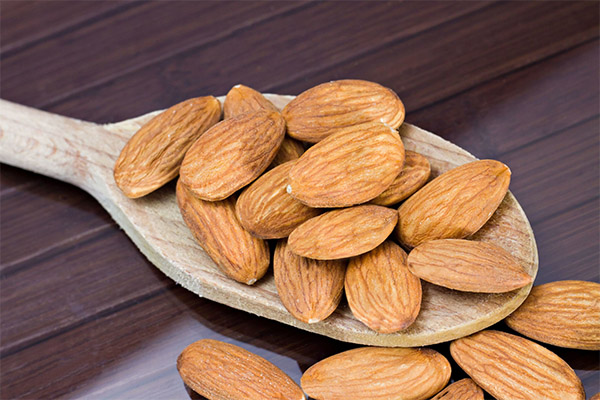
For example, for people in years, it can cleanse blood vessels and stabilize blood pressure. Almonds provide normal carbohydrate metabolism and slows the flow of sugar into the blood, so that glucose levels do not jump. A person feels satiety and digestive comfort, which is important for healthy people as well as for diabetics and dieters for weight loss.
Almonds are important for stabilizing the nervous system due to the magnesium and vitamins of group B contained in it. The nutlet keeps the brain and nerve pathways healthy for a long time, which keeps cognitive functions and clarity of mind.
Nut is also useful for digestion. It not only affects the composition of the blood and the pancreas, but also cleanses the intestines, preventing the development of constipation and normalizing the microflora of the gastrointestinal tract.
Also, the antioxidant properties of almonds make it an excellent preventive measure against the development of cancer, aging and the negative effects of the environment.
For women
Almonds for women are valuable for their anti-inflammatory properties. For many centuries, it has been used to treat sexual diseases and restore the body after childbirth. Vitamin E helps maintain water balance and relieves inflammation in the body.
Almonds are good for losing weight. Fatty nutmeal is replaced with fatty meat dishes, combining it with vegetables, eggs and dairy products. Small amounts of almonds help to quickly saturate, remove toxins and maintain healthy liver and brain during diets.
Almond kernels are rightly considered a rejuvenating remedy. Regular use of grains improves the complexion, makes the skin and hair silky, eliminates the rash, improves body odor. Almonds stimulate the production of elastin, thanks to which the skin is tightened, and the contours of the face and body become elastic and attractive. It is not without reason that almond oil is widely used in cosmetics not only for the face, but also for the body - in massage balms, scrubs and wrap mixtures.
Some experts even argue that this nut is a strong aphrodisiac, awakening in women sensitivity and desire, as in the years of early youth.
Almonds will also be useful for restoring vascular elasticity, which will help cure varicose veins and hypotension, improve blood supply to certain parts of the body, get rid of cellulite, accelerate hair growth and tighten the chest in a natural way.
For men
Since ancient times, almonds have been considered one of the most powerful treatments for prostatitis and other male ailments. It eliminates inflammatory processes, promotes the regeneration of healthy tissues, helps restore healthy blood supply, thereby improving erectile potential.
The improving effect of almonds on the cardiovascular system ensures the prevention of heart attacks and the development of atherosclerosis. Almonds contribute to healthy muscle development and can be a major source of protein, along with other nuts, for vegetarians and raw foodists.
During pregnancy
The benefits of almonds during pregnancy are not only to support the development of a healthy fetus thanks to vitamins, minerals and valuable amino acids, but also manifest in the maintenance of physical fitness. The nut stimulates the production of collagen, which helps to avoid stretch marks, and after childbirth - quickly restore the figure.
At the same time, the almond nucleoli will help to quickly satisfy hunger, avoid the development of anemia and maintain the nervous system, eliminating mood swings and sleep disturbances.
When breastfeeding
During lactation, the almond nut is valuable in its high calcium content. It enriches milk, makes it palatable and easily digestible. Also, a nut will help a woman protect her breasts from discomfort, moisturize her skin and make her supple.
For kids
In a child’s diet, almonds are a source of protein and calcium. It gives satiety, promotes the development of the brain and immunity, helps to develop strong muscles, protects children's teeth from decay, promotes the rapid healing of abrasions and prevents the formation of scars.
Almonds energize for several hours and help the baby avoid an unpleasant feeling of hunger during the day. In this case, a nut strengthens the immune system, thereby reducing the frequency of colds and infectious diseases.
Which almonds are healthier: raw or toasted
There are many ways to eat almonds. Adherents of naturalistic nutrition insist that it contains extremely harmful phytic acid compounds, which is why soaking becomes the best way to prepare it. For this, nuts are poured with brine in a ratio of 1: 2 and kept in salt water for 12–16 hours. After that, harmful substances come out of them, and the kernels become edible.
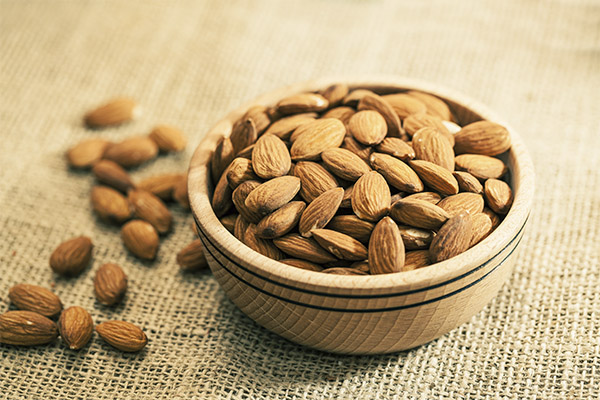
Those who are not afraid of the harsh effects of plant proteins and acids recommend eating raw almonds while all the nutrients are active in it. Experts warn that it is desirable to peel raw almonds from the husk, because it contains more of that phytic acid.
Roasted almonds are slightly inferior to the raw version and are suitable for people with intolerance to nut proteins. If raw nuts cause heaviness in the intestines, flatulence or heartburn, it is better to use them in a calcined form. But if this method of treatment did not eliminate swelling and discomfort, then this indicates an allergy.
Roasted almonds can be easier to digest and interact with other foods. It is necessary to judge which type of treatment is suitable only from personal experience, since each organism has its own needs and capabilities.
How to fry
Fry the almonds to the table or to add to the dishes easily. There are several ways to deliciously roast almonds. One of them is to bake nuts in the oven. To do this, it is advisable to choose a temperature of 60 degrees, not to overdry the fruits, but just let them lightly brown. During such roasting, you must remember to stir the nuts so that they fit evenly and do not burn.
Another way is to use a frying pan on the surface. The kernels can be calcined on a dry surface, constantly altering, or making a snack - sweet sweets or salty snacks. To get a delicious salted almonds, you can warm it in a large amount of stone powder, sprinkled in a pan - the salt absorbs excess moisture and harmful substances, and also gives the nuts a delicate aftertaste.
You can fry nuts in oil with the addition of your favorite spices - turmeric, fragrant herbs, cinnamon or cloves. It should be borne in mind that the addition of sugar syrup and vegetable or butter will significantly increase the calorie content of the product, because of which it will cease to be considered dietary and will become more difficult for digestion. The daily portion of such almonds should be reduced to 10-15 nuts.
To caramelize almonds, in a pan you need to melt a spoonful of butter and add 2-3 tablespoons of sugar, if desired - brown, it will give a subtle burnt aroma. After that, “stew” the kernels in a red-hot mixture under the lid, stirring occasionally, and finally remove the lid so that they are covered with thickened syrup on all sides.
Almond oil: benefits and applications
Almond oil is squeezed out of the nuts in a cold way, so that a maximum of antioxidants, vitamins and other beneficial substances remains in the liquid. It has healing, regenerative and nutritional properties, due to which it is introduced into the diet and is widely used in cosmetology.
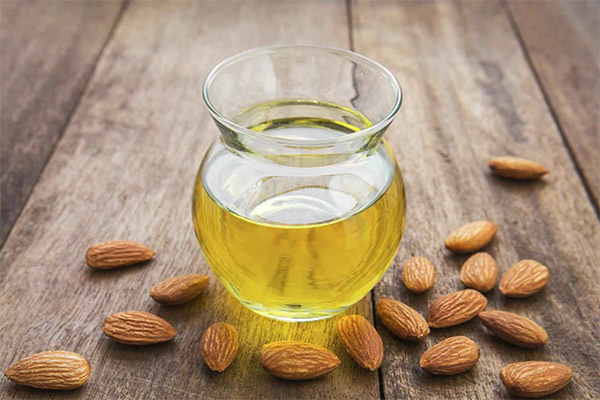
Almond oil can be an excellent base for many homemade cosmetics:
- Moisturizing and nourishing creams for dry and sensitive skin.
- Emollient balms that smooth out irregularities heal damage to the skin and make it toned and silky.
- Masks for face, body and hair, giving shine, smooth texture, saturating with moisture.
- Massage mixtures for rejuvenation, skin tightening, getting rid of the "orange peel", stretch marks, relieving fatigue.
In dietary nutrition, almond oil helps restore the pH of the gastrointestinal tract, relieve symptoms of gastritis and other inflammatory diseases, and support liver health. It serves as a prebiotic to restore normal digestion, and also gently cleanses the intestines and prevents constipation.
Almonds are also recommended for cores, diabetics and people suffering from atherosclerosis for the natural cleansing of blood and blood vessels, strengthening elastic tissues, maintaining their tone and health.
Locally with almond oil, you can lubricate damage such as hemorrhoids, insect bites, acne marks, seborrheic areas with peeling. This nourishes the cells, accelerates their renewal, relieves itching, tightness and other unpleasant sensations, and helps to avoid the appearance of a scar or age spots.
The benefits of bitter almonds
Bitter almonds are distinguished by the presence of toxic compounds, which, along with their negative properties, are famous for their antitumor effect. In addition, the bitter varieties of noble almonds are an anesthetic, are used to combat parasites, treat joints. Previously, the people treated the airways with the fruits of bitter almonds and used it as a sedative.
Useful properties of almond milk
Almond flavored milk is one of many favorite delicacies, especially those who like diets, vegans and people with intolerance to animal dairy products. Almond milk is a delicate and tasty product with a nutty smell and soft texture. It is used as the basis of cocktails, added to coffee, to cereals and smoothies, in soups, purees and sauces. A nutritious and fortified product not only replaces animal products, but is also perceived as an independent treat.
How to do
Finding almond milk on store shelves is not a problem today, but anyone who doubts the quality of production raw materials can make it without much effort at home - without preservatives, emulsifiers and chemical additives.
Homemade almond milk recipe is simple:
- 1 cup raw almond kernels;
- 3 cups of cool drinking water;
- auxiliary components: 1-2 cups of boiling water, cold drinking water, salt.
Previously, the kernels need to be washed and soaked overnight with a small amount of salt. The almonds will swell, and the water will cloud slightly. Then the raw materials need to be cleaned. To do this, boil the almonds for 2 minutes in boiling water, then pour over cold water and remove the "clothes". If you do not remove the husk, the milk will turn out to be heterogeneous and pungent in taste.
Put the resulting workpiece in a blender and pour 1 cup of water. Grind the mass until smooth, then add the remainder of the water - and mix again. Finished milk must be filtered through dense cheesecloth; vanilla, cinnamon or banana mass can be added to the resulting liquid if desired.
Cake from nuts is recommended to be added as a filler in cookies, sauces and meat - it will give a slightly spicy flavor. A large amount of the residue can be dried and grated into flour.
Urbech from almonds: benefits and harms
Urbech is a nutritious dessert paste native to Dagestan. They make such an appetizer based on fatty seeds and nuts of all kinds, except for them, adding honey and butter to the paste. Thanks to its natural composition, such a dessert is considered beneficial for the body.
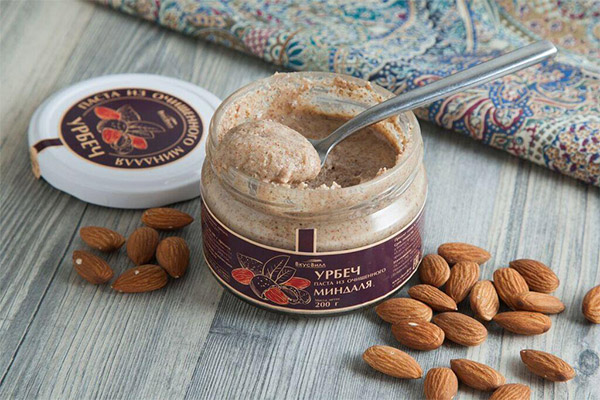
Urbech with almonds nourishes the brain and promotes rejuvenation, relieves inflammatory processes in the body. Such a product is indispensable in the cold and in intensive work - both mental and physical. Pasta perfectly supports during colds, when the body is not able to digest roughage, but is in dire need of nutrition and energy.
Fans of southern delicacies should be careful - such a paste can be eaten no more than 2 spoons a day with other food, so as not to overstrain the digestive system and not harm the figure.
Is it possible to eat almonds while losing weight
Nutritionists warn: excessive consumption of almonds can harm the figure, as well as overload the digestive organs. To easily survive the diet, you can and should introduce small portions of nuts into your diet. This will help:
- Maintain strength and energy throughout the day.
- To satisfy hunger attacks due to the satiety of the product and the richness of fiber.
- Replace sweets thanks to the nutritious sweet taste of proteins.
- Establish digestion.
- Maintain healthy brain function, avoid hormonal disorders, emotional outbursts, apathy.
- Keep a fresh and healthy appearance, cleanse the skin, eliminate traces of stress and exhaustion.
Popular star diets include 8 almond kernels per day. They can be added to morning cereal or smoothies, eat with pastries in the form of pasta, take with you for a snack for lunch or afternoon snack, or sprinkle them with dessert for lunch. It is better not to use almonds at night: it is not only long digested, but also threatens the figure. Almonds are recommended to be eaten no later than 6-8 hours before going to bed.
Almonds in medicine
In traditional medicine, almonds have been used for a very long time. Oil was used to treat abrasions, injuries, inflammatory processes, tonsillitis, and sexual diseases. Almonds also helped normalize digestion and improve vision.
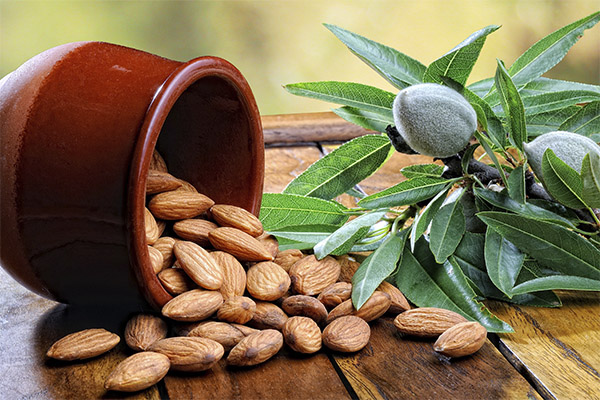
Nutritionists recommend introducing almonds into the diet for anyone experiencing mental stress and stress, physical workers, and athletes. Almonds must be present in food along with other nuts to recover from long debilitating illnesses.
Almonds, like no other nutritional kernel, are useful during diets for weight loss, for recovery after childbirth or prolonged fasting.
With diabetes
To control blood sugar, almonds are considered very effective. It slows down the flow of glucose, preventing sudden surges in sugar and thereby normalizing the patient's condition. Almonds satisfy hunger for a long time, help to keep cholesterol under control and also have a beneficial effect on the skin condition.
Caution should be taken only for those people who have diabetes accompanied by overweight and obesity. In such cases, almonds can be consumed strictly dosed - no more than 3 nucleoli per day.
Important: almond glycemic index - 10 units.
With pancreatitis
Although almonds are an anti-inflammatory agent, it is not recommended to use it after exacerbations of pancreatitis due to the high fat content and calorie content of the product. Almonds can be consumed in remission in small portions to saturate the body with valuable substances and purify the blood.
With gastritis
Almonds can be a good remedy for gastritis, it gently lubricates the walls of the stomach and helps relieve irritation. But this coin has two sides. In some cases, nuts can cause an allergic or sensitive reaction, provoke heartburn and have a choleretic effect. Before use, it is advisable to consult a gastroenterologist.
For the intestines
Almonds are good for the intestines in several ways. It helps cleanse the blood and remove toxins, toxins and unprocessed foods, which improves the absorption of nutrients.In addition, almonds can help relieve inflammation and establish a toilet routine.
For constipation
Almonds are considered a mild laxative, so with constipation it can alleviate the condition. Dietary fiber will help cleanse the intestines, and the soft texture of the almond mass will form soft stools. However, do not get involved in such a tool. In severe cases, nuts can cause bloating. Therefore, it is worth using them after cleansing the intestine with an enema to restore microflora and normalize the bowel movement.
With gout
Nuts as a fatty product in acute forms of gout are forbidden. However, in a quiet period, almonds can be eaten in minimal quantities, betting on its beneficial effect for other systems. So, for example, it significantly improves the composition of the blood and stimulates the elimination of purines, and in addition, supports the work of the heart and brain. If the disease is started, it is worth clarifying special indications from the attending physician.
For the liver
The soft, nutty texture with beneficial polyunsaturated fatty acids and vitamin E helps restore healthy liver cells, remove them from toxins, and function properly. With moderate consumption, almonds will help rejuvenate the body and give the body new strength.
With hemorrhoids
Due to the content of healing substances, almond oil, both when applied externally and in food, will contribute to the regeneration of damaged tissues, relieve swelling and inflammation, and also have a prophylactic anthelmintic effect in hemorrhoids.
With cholecystitis
Those who have discovered pathology of the gallbladder, as well as those who have experienced the acute phase of the disease, will have to temporarily exclude almonds from food - for about 6 months. At the same time, nuts are an excellent substitute for fatty meat in the diet and help regulate blood cholesterol, which is useful for patients with a designated diagnosis. For detailed nutrition instructions, consult your healthcare provider.
Almonds in cosmetology
In cosmetology, oil obtained from fragrant nuts is highly regarded. A high concentration of vitamin E and natural antioxidants makes it the most beneficial for the skin. Almonds moisturize and nourish the skin, it is especially useful for dry and sensitive skin. Almond milk gently cleanses and produces a lifting effect, stimulating collagen production, rejuvenating and renewing cells.
On the basis of almond butter and milk, you can independently prepare nutritious mixtures or add to industrial organic cosmetics - almonds are often used in skincare products due to its healing and anti-aging properties.
The use of almonds in cooking
In the kitchen, almonds are widely used not only in desserts, but also in main dishes. Many recipes came to us from Asia, but there are also European delicacies with this tender nut. The greatest value of nuts is for raw foodists and vegetarians, as well as people with intolerance to lactose or milk proteins.
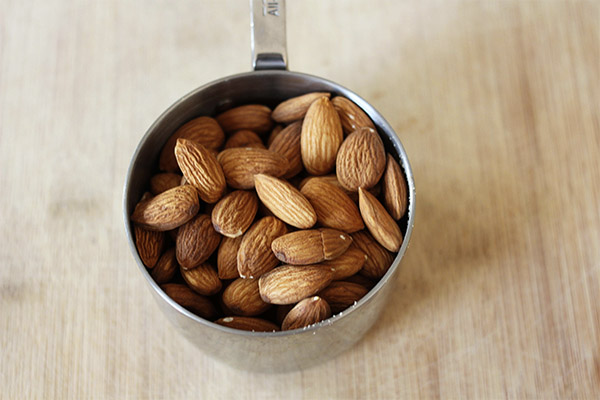
- Almonds can replace regular milk along with soy, wheat and coconut counterparts. Almond milk is rich in valuable proteins and high-quality fats, and it tastes very good.
- Almonds are used to make flour to create flavored pastries and sweets, thicken cereals, yoghurts, smoothies, milkshakes. It is added to salads and sauces to enrich them with proteins and to condense low-calorie dishes for a feeling of satiety.
- Crushed or sliced almonds become an excellent filling for casseroles, meat dishes, pies, topping for dairy and fruit desserts. Most often they are sprinkled with cereals, ice cream, cakes, and sometimes drinks.
- It is customary to season salads with almond oil and add it to desserts to give a spicy note of taste.
- Whole nuts are taken with you as a snack, added to breakfast or complement them with side dishes in dining complexes.
- Often almonds can be found in confectionery.It is chosen as a filler for chocolate, made from it fondant sweets, marshmallows and marzipan, complemented by grill and kozinaki. You can find almond halva. Fatty, but at the same time delicate fragrant almond cream is used as the basis or addition to ice cream, spreads on cakes, served with pancakes and waffles. It can also complement fruit salads.
- In main dishes, almonds can be filled with vegetable stews and salads, stuffed with baked poultry, and added to sauces and cream soups.
- Almonds go well with dark, milk and white chocolate, sesame seeds, coconut, in harmony with the tastes of cherry, orange, peach, pumpkin. From vegetables, it is combined with tomatoes, peppers, eggplant, onions, as well as fish, red meat, cream and honey. Among the spices, almonds are suitable for cinnamon, turmeric, nutmeg, saffron and fragrant herbs.
- Almonds are used both raw and calcined. As a snack, kernels can be fried in oil with salt and seasoning, caramelized in sugar and honey, combined with spices.
Harm and contraindications
Almonds are not the safest nut. It contains a small amount of amines and salicylates, as well as amygdalin - these substances can cause allergic reactions and even poisoning the body. Therefore, before using the nut regularly, you should make sure that there is no allergy to it.
Another side effect of eating almonds is a “causeless” headache. This happens due to the harmful compound in the almonds that provokes migraines. If such a symptom is detected, it is completely optional to refuse a nut; it is enough to reduce portions and observe whether the unpleasant symptoms recede.
The third "sin" of the almond nut is its high calorie content. Almonds, like other nuts and seeds, contrary to the traditions of many cultures, are not recommended for use in combination with sugar, honey and fatty oils, so as not to aggravate the work of the liver, pancreas and gastrointestinal tract.
An overdose of nuts can cause poisoning, which is manifested by symptoms of nausea, headache, cramping in the digestive tract, dizziness, and general malaise. In such cases, washing is necessary, and activated carbon may serve as a temporary measure.
Almonds are recommended to be used cautiously for people with sensitive gastrointestinal tract, who have suffered heart attacks and diseases, and for patients with pathologies of the nervous system. In the case of acute diagnoses, it is necessary to consult your doctor about acceptable products and an individual diet.
Almond Allergy Symptoms
Such an unpleasant condition as an allergy is always accompanied by swelling of the lymph nodes, an increase in body temperature, as well as itching or skin rashes. In addition, in the case of almonds, headache, nausea, diarrhea, intestinal cramps and flatulence, muscle discomfort, tearing, and mood swings can occur.
The easiest way to check if the body does not respond to almond fruits by rejection is to take a few drops of oil and apply it on delicate areas of the skin on the inside of the hand. But sometimes this is not enough. Then it is necessary to exclude any other potential allergens from food at the time of inspection and add almonds to safe foods. In case of unpleasant symptoms, the allergy will be determined in relation to the almond.
Allergic reactions to almonds are a serious signal from the body, because the product is really potentially dangerous. Perhaps the patient’s body with an allergy is more sensitive to nut poison. Almonds should never be consumed in excess of the norm.
How to choose and store almonds
When choosing almonds, the buyer should be interested in the freshness of the nuts and the correct choice of variety. The less time has passed since the collection, the more nutrients are stored in the product. Fresh almonds will have a light grassy-nutty smell, a whole skin that protects the kernels from mold and other lesions, an even shade without spots and plaque.
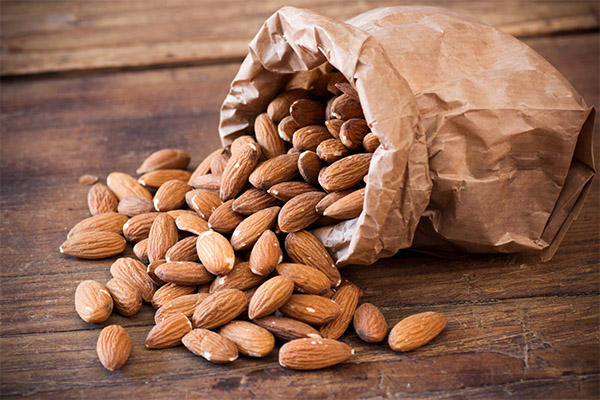
It is important to distinguish sweet noble almonds from apricot kernel. A true walnut fruit has a regular elliptical shape without kinks, it is oblong and usually about 1.5 cm long. The taste and smell of such a fruit are delicate, silky, slightly dairy.
Bitter almonds have a shape resembling a sunflower seed - with a wedge at the tip. If the noble nut has a pronounced striped skin with a soft relief or without it, then the fruit seeds have a plain reddish-beige coating and many small wrinkles on the surface. The taste of the seeds is less creamy, harsh with bitterness, reminiscent of cherry, sometimes a little “alcoholic”.
Since the peel of the almonds is dense, it should not be peeled off, otherwise we can say that the nut is stale, overdried or spoiled.
During storage, it is important to protect the nuts from oxidation in the open air and in direct sunlight. You can store them in the refrigerator or even in the freezer - then they will not go rancid. The best option is a glass jar or a dense pouch.
How to eat almonds
Since the product is a potential allergen and is rich in oils and protein, which can be difficult for the digestive system, it is recommended to use it dosed. At the same time, not every organism calmly tolerates raw almonds, so in some cases it needs to be fried.
Typically, difficulties with the digestion of almonds arise due to complex proteins and fiber in its composition, which significantly change their structure during heat treatment. To get the most out of almonds, it is recommended to use its fresh cold oil and heat-treated flour or nuts.
How much can you eat per day
It is advisable to introduce a nut into baby food no earlier than 4 years, starting from the 1st, and then 2-3 nucleoli. At school age, you can offer children up to 8 nuts. For adults, cardiologists and nutritionists recommend a daily norm of 30 g of almonds - this is about 22-23 grains (a small handful). Men can eat 3-5 nuts more than women, due to the characteristics of metabolism. Eating almonds is enough 3-4 times a week, with daily eating of this type of nuts, the norm can be reduced.
Almonds should be used cautiously for old people, people with gastrointestinal problems, gall bladder, brain, because the fetus may be difficult for an exhausted body. In controversial cases, it is appropriate to consult a doctor about the norms of use of the product in each individual case.
No matter how useful the almonds, it is worth alternating it in the diet with other nuts and grains, as well as balancing the menu, replacing rich nuts, meat, eggs, fat cheese or sour cream. Then the body will receive everything you need, while maintaining high efficiency, vitality and a healthy fresh look.
Can I eat at night and on an empty stomach
Eating almond fruits before bedtime is not recommended due to the severity of its food substrate. It is advisable to use nucleoli in the morning or at lunch. It should also be borne in mind that fasting nuts is undesirable for the same reasons - first the body needs to wake up, and only later - for lunch - start digesting complex foods.
Nevertheless, soft almond milk in combination with other products - especially herbs and non-sour fruits - will be an excellent cocktail for breakfast.Someone even prefers to cook omelet with such an additive.
Is it possible to eat raw almonds
Experts argue about whether raw almonds can be eaten today: some say that it contains harmful phytic acid and nuts, at least they need to be soaked, while others say that only fresh raw kernels retain a maximum of useful substances and antioxidants.
To reduce the harmful effect of the nut, nutritionists recommend peeling it of husks at least half the time, and also if you want to leave the nucleolus in brine overnight before use.
Is it possible to eat with a peel
In the skin of almonds there are no particularly harmful substances, on the contrary - it is a valuable fiber, so you can use it. But if this ruins the appearance of the dish or the consistency of the cream, it is better to remove the husk.
Do I need to wash before use
If you bought nuts by weight in a supermarket or a specialized shop, it is definitely worth rinsing them in several waters, holding them under an aerated stream, or even pouring boiling water over them. This will help to mechanically wash away all dust, foreign matter and bacteria from them. After all, before hitting the table, nuts go a long way, lie on the shelves, and sometimes, when the seller does not comply with storage conditions, they even become covered with a fungus. This is another argument in favor of freeing the nucleoli from the peel before eating.
How to quickly peel almonds
When almonds are used for decoration or added to delicate cream and sauces, the peel can ruin the whole look. In such cases, it can be quickly and easily removed. There are 2 easy ways.

It is necessary to place the almonds in boiling unsalted water for 2-3 minutes, then catch and add cold water. The kernels in such conditions do not have time to boil, but the peel lags behind the temperature difference. After that, it can be easily removed and dried on paper towels.
Another way is to pour grains with boiling water for 15–20 minutes. After cooling down, try: if they are cleaned well, get down to business; if 1 procedure is not enough, repeat the “bathhouse”.
The remaining husk does not have to be thrown into the trash - it can be useful for cosmetic or medicinal purposes. The dried peel can be infused in water and get an excellent moisturizing lotion for face and body or hair rinse. Since vitamins and valuable compounds accumulate not only in the nuclei, but also in the husk, the product perfectly nourishes and refreshes the skin and hair, strengthens nails, increases elasticity and eliminates peeling.
How to make almond flour at home
In industrial or domestic conditions, flour is usually made from low-fat meal, that is, almond meal. First, full kernels are passed through a press to expel all the oil by cold pressing. Remains dry matter, consisting of nutty proteins and dietary fiber. Such raw materials are a dietary product that does not contain excess calories, but at the same time nourishes the body with valuable “building material” and promotes cleaning.
The remaining cake is dried in the oven, evenly distributing the wet mass over the sheet, after which the resulting dust can be ground in a coffee grinder, mortar or blender - in any convenient way. The result is a gentle cream powder that will make many dishes healthy and tasty and will be an excellent organic supplement to home-made protein shakes for athletes, fitness models, pregnant women, vegans, and anyone who prefers a healthy diet.
Is it possible to give animals almonds
It is very important to ensure that poultry or pets do not eat bitter almonds - this is extremely dangerous for their life because of the content of hydrocyanic acid in the fruits. Noble varieties are also undesirable in the diet of animals, especially small ones.Often, experts warn that it is not worth giving almonds to squirrels, poultry and other animals.
It is recommended to give nuts to dogs for the growth of healthy shiny coat and overall health of the body. But it must be borne in mind that even a sweet variety can cause diarrhea in the animal and provoke more serious disorders. 1-2 nuts accidentally eaten, maybe they will not cause harm, but regular use will harm the health of the pet.
Interesting Almond Facts
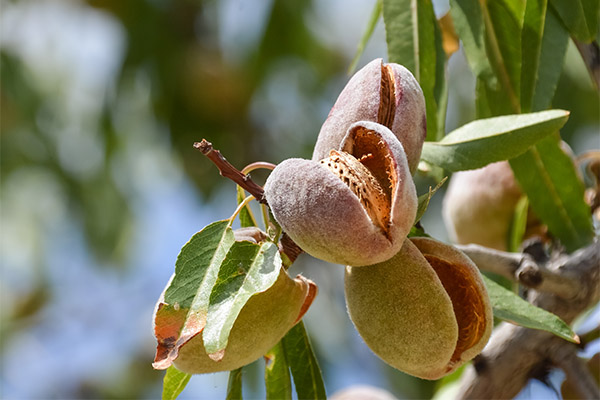
- From a botanical point of view, the almond tree is a type of plum. That is why the flavor of its grains is so similar to other odors of the Rosaceae family - apricot, cherries, peaches.
- On New Year's Eve in Switzerland, a holiday cake is baked and an almond kernel is hidden inside. Anyone who comes across such a surprise, according to legend, will live in abundance all year and will meet his happiness.
- Initially, almond flour was considered a sedative and only later it began to be used in confectionery.
- Almonds bloom in mid-winter, therefore, on the southern shores of Europe - in Spain and Portugal, they celebrate the Day of Flowering Almond Tree.
- The oil obtained from bitter varieties of almonds is cleaned of toxic impurities and used in the production of elite soaps.
- They say that almonds were one of the favorite delicacies in Ancient Egypt, and only aristocrats served delicacy.
«Important: all information on the site is provided exclusively in fact-finding purposes. Before applying any recommendations, consult with a profile specialist. Neither the editors nor the authors are liable for any possible harm caused materials. "

